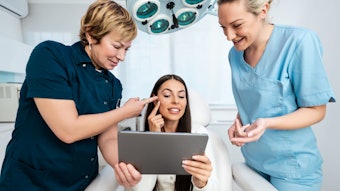
In the ever-evolving realms of aesthetics, medical and cosmetic dermatology, a remarkable revolution propelled by the integration of artificial intelligence (AI) and augmented reality (AR) technologies has unfolded. This transformation is fundamentally altering how practitioners approach diagnostics, treatment planning and patient engagement. With more than 15 years of experience as a practitioner in this field, I've been thrilled to witness how these cutting-edge tools are empowering providers and revolutionizing the patient experience.
Enhancing Consultations with Artificial Intelligence
At Siperstein Dermatology Group, we have harnessed these technologies to deliver enhanced consultations and gain unprecedented insights. The adoption of AI and AR technologies is redefining cosmetic and medical dermatological consultations, making our diagnostic procedures, treatment planning and outcomes more efficient and effective.
VISIA 2D Facial Imaging: For instance, 2D facial imaging systems enable me to capture standardized images of patients' left, right and frontal views. The VISIA Skin Analysis System by Canfield is able to take these images and, using AI-driven scoring, almost instantaneously evaluate key skin features both on the surface and subsurface, identifying spots, wrinkles, texture, pores, UV spots, RBX Brown, RBX Red and Porphyrins in great detail. This not only provides high quality visualization, but also generates crucial scoring metrics. Complex algorithms calculate the number and distribution of spots within the evaluated area and assign a percentile score, facilitating comparison with individuals of the same age and skin type within the VISIA database. This meticulous accuracy in assessing our patients' current skin conditions enables the creation of highly customized, accurate treatment plans.
The significance of these scores lies in their role in crafting personalized treatment strategies with unparalleled precision. This departure from generic, one-size-fits-all approaches significantly increases the likelihood of optimal, tailored results for each patient. Moreover, the standardized capture process allows for meaningful comparisons and objective tracking over time, enabling better assessment and adjustments in follow-up consultations.
HairMetrix: AI's impact extends beyond facial applications. Canfield's HairMetrix software is the first AI-driven, real-time hair analysis tool. This technology revolutionizes consultations related to hair transplantations, platelet-rich plasma (PRP) treatments, and hair and scalp care. Its unclipped insights, immediate in-depth analysis of follicle count, anagen/telogen ratio and individual hair follicle growth rate documentation enable swift, precise decisions, especially for urgent cases or patients reluctant to sacrifice thinning hair for analysis.
With other game changing AI tools in development, such as the total body photography system called IntelliStudio DermaGraphix, used in monitoring and evaluating suspicious skin lesions, AI is showing tremendous potential and success in ongoing research for its ability to profoundly aid in dermatologic consultations and accurate diagnosis.
Incorporating Augmented Reality: Combining AI & AR in Consultations
Augmented reality (AR) takes the information and data gained from AI analysis tools and transforms them into a simulation that patients can engage with visually to enhance the consultation experience. AR is an incredible tool for helping demonstrate how certain treatments, changes in skin care regimen and other aspects of a patient’s aesthetic goals discussed during consultations will affect their appearance and ability to maintain their natural beauty as they age. This makes the experience much more collaborative and helps engage patients in actively achieving their aesthetic goals with the help of their physician. As the saying goes, “Seeing is believing.”
VISIA Advanced Aging Simulation: Understanding that each patient's skin care needs, age, genetics and aesthetic goals differ significantly, VISIA's Advanced Aging Simulation, utilizing AR technology, has been transformative when it comes to patient consultations. This simulation, demonstrating a patient's appearance up to 80 years old in real-time, serves as an engaging visual aid. It guides targeted focus for early prevention and highlights areas needing attention to minimize future damage such as sunspots or wrinkles. This tool actively engages patients in the decision making process, motivating proactive skin care and fostering collaborative efforts to maintain graceful aging.
VECTRA 3D: 3D imaging technology utilizing AI in combination with AR simulations of treatment results is another exciting new tool for enhancing patient consultations and treatment outcomes. One such 3D AI/AR aesthetic tool is the VECTRA 3D imaging system, which utilizes software that combines AI Skin Analysis scores with simulations of both surgical and non-surgical facial procedures. In addition, VECTRA also assists in consultations for other treatment areas in medical aesthetics, allowing for 3D imaging of the breasts and body, with software capable of capturing and analyzing automated measurements specific to breast augmentation and body sculpting procedures to simulate treatment outcomes. This comprehensive approach allows practitioners to discuss patient outcomes more holistically, seamlessly elevating complexion and simulating realistic 3D results within a singular software interface.
Leveraging AI & AR Technologies
By leveraging these advanced tools, my team and I not only offer a diverse range of services tailored to customers' needs but also provide personalized insights. These technologies empower practitioners across fields to deliver highly customized treatments, ensure superior outcomes and actively engage patients in their care journey.
Contrary to any perceived complexities, integrating AI and AR technology into my practice has been remarkably seamless for my staff. The intuitive interfaces and user-friendly design of AI-enhanced systems have facilitated their swift adoption into our daily routines, enhancing the patient experience, expediting diagnostics and ensuring more accurate skin condition assessments.
In conclusion, AI and AR technologies are reshaping the landscape of aesthetic and medical dermatology. This revolution heralds an era defined by precision, personalization and patient empowerment, setting a new industry standard. Committed to remaining at the forefront of these transformative technologies, I firmly believe that AI and AR will continue to revolutionize our field, empowering both practitioners and patients and establishing new benchmarks for personalized, effective care. The future has arrived, and I am excited to be an active participant in this extraordinary journey toward excellence in aesthetics and dermatology.












